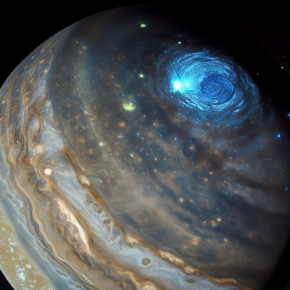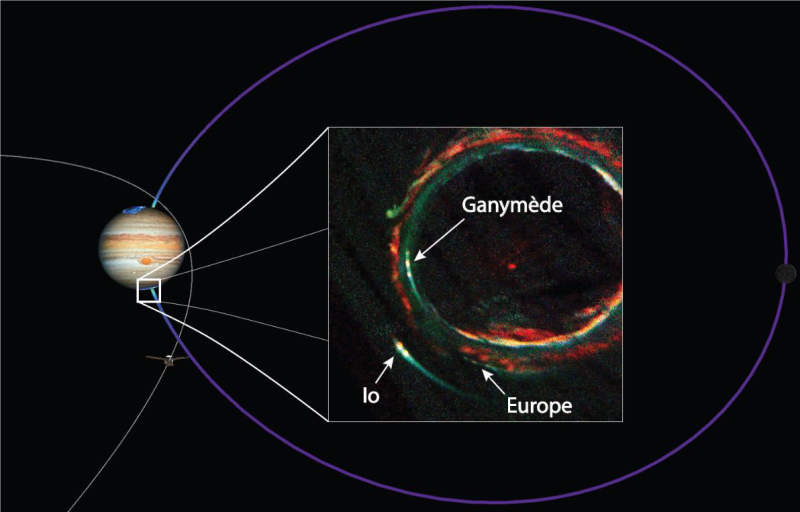
Jupiter exhibits the brightest auroras in the Solar System. One of the peculiarities of this planet, which it shares with Saturn, is that it also possesses auroral emissions caused by three of its largest moons: Io, Europa, and Ganymede. These distinct emissions, called ‘auroral footprints,’ are locally visible in several wavelength domains. They are created by charged particles, predominantly electrons, that propagate along magnetic field lines connecting the moons to Jupiter. As these electrons precipitate into the giant planet’s atmosphere, they induce characteristic auroras, which have been studied since the 2000s, notably through observations from the Hubble Space Telescope in the ultraviolet domain.
Since July 2016, the Juno probe has been flying over Jupiter’s poles at just a few thousand kilometers altitude, allowing for a detailed characterization of the moons’ auroral footprint structures. The combined analysis of data obtained by Juno’s UVS spectrograph and JADE spectrometer enables probing both the properties of these emissions and those of the charged particles that induce them.
Focusing their study on the auroral footprint of Ganymede, the largest moon in the solar system and the only one generating its own magnetic field, a team of scientists from IRAP in Toulouse and LAM, in close collaboration with Juno mission teams (SwRI, Princeton University), has, among other things, demonstrated the influence of Ganymede’s mini-magnetosphere on its auroral footprint. They confirmed that the size of the flux tubes, these tubular-shaped magnetic field lines connecting the moons to Jupiter’s atmosphere through which electromagnetic waves and charged particles propagate, is significantly larger than those reported for Io and Europa in previous studies. Juno’s observations of the auroral footprint thus provide a new method for studying Ganymede’s mini-magnetosphere, which will be explored in situ in an unprecedented manner by ESA’s JUICE mission currently en route to Jupiter, in which LAM and IRAP are also involved.
Link to the INSU press release :
Publication : Rabia, J., Hue, V., André, N., Nénon, Q., Szalay, J. R., Allegrini, F., et al. (2024). Properties of electrons accelerated by the Ganymede-magnetosphere interaction: Survey of Juno high-latitude observations. Journal of Geophysical Research: Space Physics, 129, e2024JA032604. https://doi.org/10.1029/2024JA032604
Contact at LAM : Vincent Hue vincent.hue@lam.fr Professeur à Aix-Marseille Université / Institut Origines / Laboratoire d’Astrophysique de Marseille





